Table of Contents:
Abstract
Today’s post presents several ways of API hooking under the x86
instruction set.
Throughout the following paragraphs we will introduce the reader to API
hooking, what we can do with it, why API hooking is useful, the most basic
form of API hooking. And, after presenting a simple API hooking method,
we will cover some lesser known and used (if used at all) methods which
might come in handy one day, as well as some other techniques to keep in
mind when using any kind of hooking method.
Finally, we refer the reader to production code which will be used on a
daily basis to analyze thousands of malware samples.
Introduction
The following fragment is a brief explanation on Hooking, taken from
Wikipedia [1].
In computer programming, the term hooking covers a range of techniques
used to alter or augment the behavior of an operating system, of
applications, or of other software components by intercepting function
calls or messages or events passed between software components. Code that
handles such intercepted function calls, events or messages is called a
"hook".
So, we’ve established that hooking allows us to alter the behaviour of
existing software. Before we go further, following is a brief list of
example uses of hooking.
- Profiling: How fast are certain function calls?
- Monitoring: Did we send the correct parameters to function X?
- ..?
A more comprehensive list of why one would want to hook functions can be
found here [1]
[2].
With this list, it should be clear why API hooking is useful. That being
said, it’s time to move on to API hooking itself.
A small note to the reader, this post does not cover
breakpoints, IAT Hooking, etc. as that
is an entire blogpost on its own.
Basic API Hooking
The easiest way of hooking is by inserting a jump instruction. As you
may or may not already know, the x86 instruction set has a variable length
instruction size (that is, an instruction can have a length between one
byte and 16 bytes, at max.) One particular instruction, the unconditional
jump, is five bytes in length. One byte represents the opcode, the other
four bytes represent a 32bit relative offset. (Note that there is also an
unconditional jump instruction which takes an 8bit relative offset, but we
will not use that instruction in this example.)
So, if we have two functions, function A and function B, how do we
redirect execution from function A to function B? Well, obviously we will
be using a jump instruction, so all there’s left to do is calculate the
correct relative offset.
Assume that function A is located at address 0×401000 and that
function B is located at address 0×401800. What we do next is, we
determine the required relative offset. There is a difference of
0×800 bytes between the two functions, and we want to jump from
function A to function B, so we don’t have to worry about negative offsets
yet.
Now comes the tricky part, assume that we have already written our jump
instruction at address 0×401000 (function A), and that the instruction
is executed. What the CPU will do is the following; first it will add the
length of the instruction to the Instruction Pointer
[3] (or Program Counter), the length of
the jump instruction is five bytes, as we’ve established earlier. After
this, the relative offset is added (the four bytes, or 32bits value,
located after the opcode) to the Instruction Pointer. In other words,
the CPU calculates the new Instruction Pointer like the following.
instruction_pointer = instruction_pointer + 5 + relative_offset;
Therefore, calculating the relative offset requires us to reverse the
formula in the following way.
relative_offset = function_B - function_A - 5;
We subtract five because that’s the length of the jump instruction which
the CPU adds when executing this instruction, and function_A is subtracted
from function_B because it’s a relative jump; the difference
between the addresses of function_B and function_A is 0×800 bytes. (E.g.
if we forget to subtract function_A, then the CPU will end up at the
address 0×401800 + 0×401000 + 5, which is obviously not desired.)
In assembly, redirecting function A to function B will look roughly like
the following.
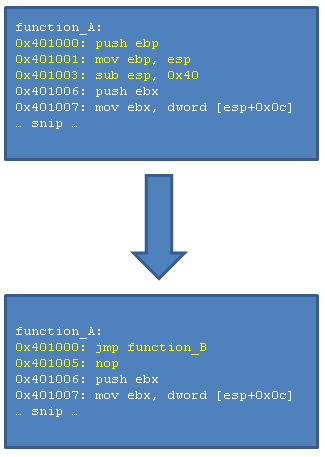
Before the hook you see a few original instructions, however, after
hooking, they are overwritten by our jump instruction. As you can see,
the first three original instructions take a length of six bytes in total
(i.e. you can see that the push ebx instruction is located at
address 0×401006.) Our jump instruction uses only five bytes, which leaves
us one extra byte, we have overwritten this byte with a nop
instruction (an instruction that does nothing.)
The instructions that have been overwritten are what we call
stolen bytes, in the following paragraph we’ll go into
more detail about them.
Trampolines
So, we’ve hooked function A and redirected it to function B. However,
what happens when we want to execute the original function A, without
executing the hook? In order to do this, we have to make a so-called
trampoline function.
The following snippet shows a simple example of using a Trampoline to
execute the original function from the hooking function, where
function_A_trampoline denotes the Trampoline to function A (the
function which is being hooked.)
// this is the hooked function
void function_A(int value, int value2);
// this is the Trampoline with which we can call
// function_A without executing the hook
void (*function_A_trampoline)(int value, int value2);
// this is the hooking function which is executed
// when function_A is called
void function_B(int value, int value2)
{
// alter arguments and execute the original function
function_A_trampoline(value + 1, value2 + 2);
}
In the hooking example which we have just discussed, we have overwritten
the first five bytes of function A. In order to execute our original
function, without the hook, we will have to execute the bytes which we
have overwritten when installing the hook, and then jump to the address of
function A plus a few bytes (so we will skip the jump.) This is
exactly what happens in the code snippet above, but you don’t see that in
the C source, because it’s all abstracted away. Anyway, an image says
more than a thousand words, so.. here’s an image which shows the internal
workings of the Trampoline.
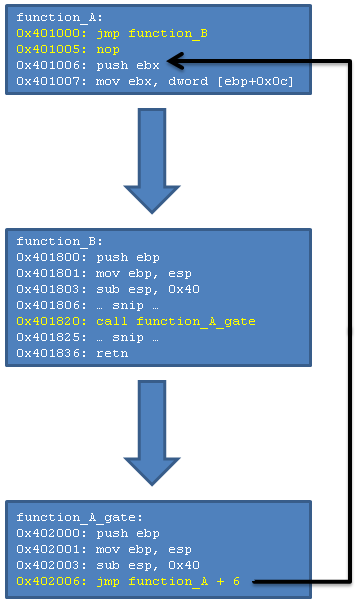
In the image you see the following execution flow; function A is called,
the hook is executed and therefore execution is now in function B.
Function B does some stuff, but at address 0×401820 it wants to execute
the original function A without the hook, this is where the Trampoline
kicks in. Many, many words could be written about the Trampoline, but the
image explains it all. The Trampoline consists of exactly two parts; the
original instructions and a jump to function A, but past the hook. If you
grab the image from the Basic API Hooking section,
then you can see that the instructions which were overwritten, are now
located in the Trampoline. The jump in the Trampoline is calculated simply
using the formula which we discussed earlier, however, in this particular
case the addresses and offsets are a bit different, so the exact formula
goes as following.
relative_offset = (function_A_trampoline + 6) - (function_A + 6) - 5;
Note carefully that we jump from 0×402006
(function_A_trampoline + 6) to 0×401006 (function_A + 6.)
These
addresses can be verified in the image above. Nothing special, except for
the fact that we will end up with a negative relative offset, but that
doesn’t give us any problems (i.e. the CPU does all the hard work of
representing the correct negative relative offset.)
This is actually all there is to know about basic API hooking, so we will
now discuss some more advanced methods. In a later chapter,
Constructing Trampolines, we will go into more
detail regarding how to construct a Trampoline.
Advanced Hooking Methods
We have seen Basic API Hooking and
Trampolines. However, because this method of
hooking is so simple (inserting a jump instruction), it is also really
easy to detect. Therefore we will talk about some more advanced
methods as well. Besides that, we will also give an introduction to
Hooking C++ Class Methods.
Detection of the example in the Basic API Hooking method
goes as following.
if(*function_A == 0xe9) {
printf("Hook detected in function A.\n");
}
This is because 0xe9 is the opcode for a jump with a
32bit relative offset. Depending on the software which we hook, it may or
may not detect such hook. In any case, we will discuss various methods
which try to bypass such detection algorithms. (Note that software such as
GMER [4] detects all types of hooking
methods, because it checks virtual memory against the physical image on
the disk.)
Method I: Prepend a Nop
This is a really simple workaround, and works with any of the methods
which will follow as well.
Basically, instead of writing for example the jump instruction at function
A, we will first write a nop instruction (an instruction which does
nothing), followed by the jump instruction. When applying this technique,
do note that that the jump instruction is now at address 0×401001
(function_A + 1), which alters the relative offset by one.
An image to show this technique follows.
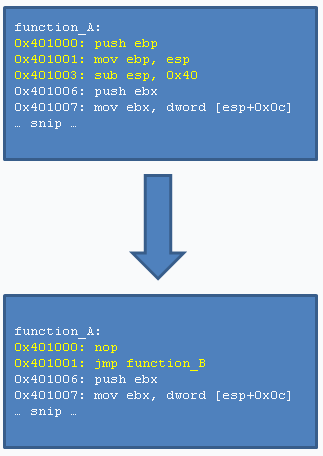
Because the first instruction at function A is now a nop
instruction, and not a jump instruction, we’d have to rewrite the
detection method to something like the following in order to detect it.
unsigned char *addr = function_A;
while (*addr == 0x90) addr++;
if(*addr == 0xe9) {
printf("Hook detected in function A.\n");
}
Basically it skips any nop instructions, which have 0×90
as opcode, and checks for a jump after all the nop instructions.
Method II: Push/Retn
The push instruction pushes a 32bit value on the stack, and the
retn instruction pops a 32bit address off the stack into the
Instruction Pointer (in other words, it starts execution at the address
which is found at the top of the stack.)
This method is six bytes in total, and looks like the following. Note that
the push instruction takes an absolute address, not a relative one.
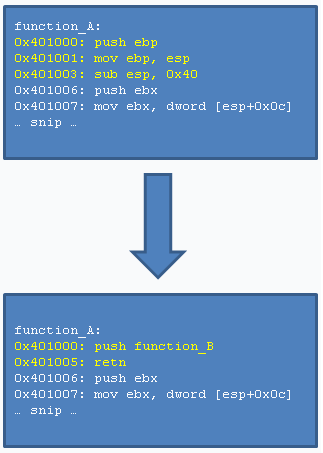
Detection of this technique might look like the following, although keep
in mind that prepending nop instructions, or placing a nop between the
push and retn instruction will not be detected by the following code.
unsigned char *addr = function_A;
if(*addr == 0x68 && addr[5] == 0xc3) {
printf("Hook detected in function A.\n");
}
As you’ve hopefully figured out by now, 0×68 is the
opcode for the push instruction, and 0xc3 the opcode for
the retn instruction.
Method III: Floating Points
Whereas the methods discussed so far concentrated on normal x86
instructions, there are also some interesting methods involving floating
points, and whatnot.
This example is like the push/retn method, we push a dummy value on the
stack, we then overwrite this dummy value with the real address, and then
we return.
What is interesting about this technique is the following; instead of
storing the address to jump to as a 32bit address, we store it as a 64bit
floating point. We then read it (using the fld instruction), and
translate it to a 32bit value (using the fistp instruction.)
The following picture demonstrates the technique, the hook uses eleven
bytes, so that’s a little bit more than the previous methods, but it’s
still a nice method. Also note that floating_point is
a pointer to the 64bit floating point value which contains the address of
our hook function.
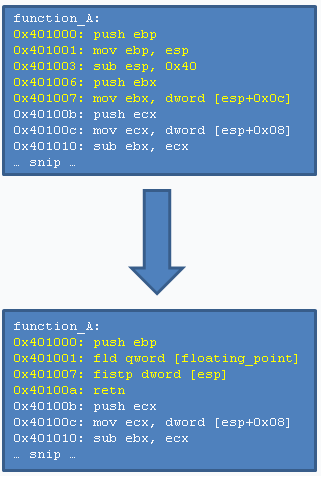
Constructing the floating point is fairly easy, and goes as following.
double floating_point_value = (double) function_B;
Where function B is, as with the previous examples, our hook function.
Calling the original function is done through a
Trampoline, just like with the other methods.
(Except in this case the Trampoline will have to contain atleast the
instructions which are found in the first eleven bytes of the function.)
Obviously this is only the tip of the iceberg, there are many floating
point instructions which might be useful for this situation. E.g. you
could calculate the hook address by multiplying a value to π (Pi, which
can be obtained using the fldpi instruction.)
Method IV: MMX/SSE
This technique is similar to that of hooking using
Floating Points. However, instead of using
Floating Points, we use the MMX/SSE x86 extensions here.
Both techniques use, like the Floating Points technique, the push/retn
method. The first method involves the MMX instructions, particularly
the movd instruction. It allows, just like the
fistp instruction (a Floating Points instruction) to read a value
from memory, and store a value to the stack. The second method, using the
SSE instructions, utilizes the same movd instruction.
The only difference between the two methods is the fact that MMX
instructions operate on 64bit registers, whereas the SSE instructions
operate on 128bit registers. (Although this is not interesting in our
case, because the movd instruction allows reading and writing of
32bit values.)
Either way, as this technique is exactly the same as the Floating Points
one, except for the instructions that are being used, there is no image
(no need to flood this article with images..)
Method V: Indirect Jump
An indirect jump is basically saying, jump to the address which can be
found here. In the Basic API Hooking
section we introduced relative jumps, they are direct jumps. Indirect
jumps are more like the Push/Retn method.
An indirect jump is six bytes in length, and an example hook looks like
the following.
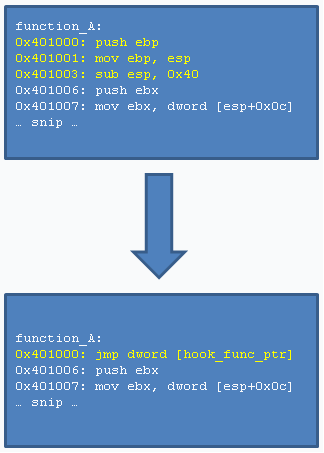
Note that the hook_func_ptr denotes an address at which
the address of our hooking function (e.g. function B) can be found.
Method VI: Call Instruction
Whereas all of the previous hooking methods jump right into the hooking
function itself (e.g. function B), this hooking method needs an additional
step. This is because the call instruction jumps to a specified
address after pushing a return address on the stack (the return address
being the current Instruction Pointer plus the length of the instruction.)
Because there is now an additional return address on the stack, we will
first have to pop this address off the stack, otherwise our stack will be
corrupted. (E.g. the hooking function will read incorrect parameters from
the stack, because the stack pointer is incorrect.) We pop this
address off the stack by adding four to the stack pointer (when the
address is pushed onto the stack, the stack pointer is first
decremented by four, then the address is written to the address pointed to
by the updated stack pointer.) After the address has been popped off the
stack, we jump to the hooking function.
This technique works for both direct and indirect variants of the call
instruction. Following is an imagine which represents the technique.
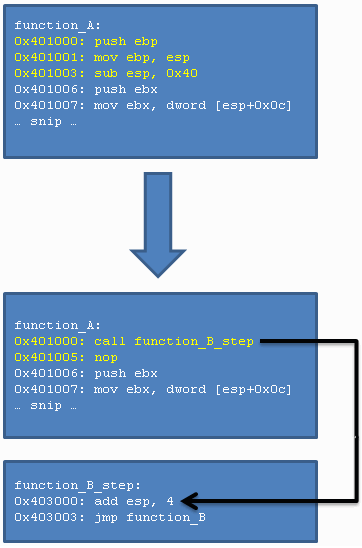
Other Methods
Besides the methods which have been discussed so far, there are also a few
other methods, with specific purposes. They might come in handy for some
situations, you never know.. ![]()
Other Methods I: Hotpatching
This is a method specific for software compiled with the Microsoft Visual
C++ Compiler, which have the Hotpatching flag enabled (this is the case
for plenty of dlls, such as user32.dll.)
If a function accepts a so-called Hotpatch, then it has been prepared in
a certain way; the first instruction of the function is a
mov edi, edi instruction (which is two bytes in length)
and there are five nop instructions before the function
itself. This allows one to place a short jump (one that takes an
8bit relative offset, and is two bytes in length) at the function address
(to overwrite the mov edi, edi instruction) and a normal jump with
a 32bit relative offset at the place of the nop instructions.
And yet again, that’s all there is to this technique. Note that, instead
of Hotpatching such function, it is also possible to hook the function
using one of the other methods explained in this article by placing the
hook on the address function+2, where two denotes the size of the
instruction inserted for Hotpatching. (This way one could still apply a
Hotpatch, even though we already hook the function with one of our
favourite methods.)
An image representing Hotpatching is as follows, with MessageBoxA
being the function to hook, and hook_MessageBoxA the function where
execution goes (see it as MessageBoxA = function A, hook_MessageBoxA =
function B.)
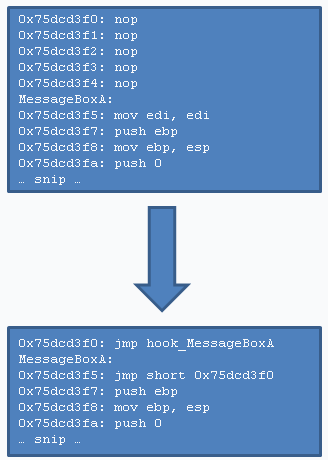
Other Methods II: C++ Class Methods
This method is regarding the hooking of C++ Class Methods. These functions
use the so-called __thiscall
[5] calling convention (or, atleast
they do on windows.)
This particular calling convention stores the object information (which
can be referenced through the this variable in class methods) in
the ecx register before calling a class method. In other words, if
we want to hook a class method, it needs some special attention.
For further explanation we will be using the following code snippet,
which defines a function (function_A) which we want to hook.
class A {
public:
void function_A(int value, int value2, int value3) {
printf("value: %d %d %d\n", value, value2, value3);
}
};
Besides that, because we want to hook C++ functions using regular C
functions, we will be interested in having the this pointer as
first parameter to our hook function. An example of our hooking function
looks like the the following, including trampoline (which will be discussed
later as well.) Note that we use the variable name self instead of
this, because this is a reserved keyword in C++.
void (*function_A_trampoline)(void *self, int value,
int value2, int value3);
void function_B(void *self, int value,
int value2, int value3)
{
return function_A_trampoline(self, value + 1,
value + 2, value + 3);
}
In order to be able to hook C++ Class Methods from a normal C source we
will have to alter the stack a bit, because we have to squeeze the
this pointer into it. The following image represents the stack
layout when function_A is called, followed by the layout how we want it
when function_B is called (the hooking function.) Note that ecx
contains the this
pointer, as outlined before, and the fact that the top of the stack is at
the address on which return_address is located.

Fortunately for us, we can squeeze the this pointer into the stack
in exactly two instructions, which is pretty neat.
The first step is exchanging the this pointer (the ecx
register) and the top of the stack (the return_address.) After this
swap we have the this pointer at the top of the stack, and the
return_address in the ecx register. From here on we can
simply push the ecx register onto the stack, and the stack will
look exactly like what we wanted (see the last image.)
Following is the assembly representation of hooking a C++ class method.
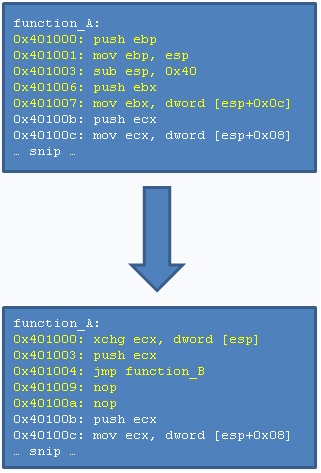
So that’s the hooking part. However, we have to adjust our
Trampoline as well, because the Trampoline
accepts a this pointer as first argument. The stack of what
we have and what we want is as follows. (The this value should
obviously be stored into the ecx register afterwards.)

We do exactly the opposite of what we did to hook the function; we first
pop the return_address off the stack, so the top of the stack
points to this, and the ecx register is loaded with the
return_address. Now we swap the top of the stack and the ecx
register, after which the stack looks as we want, and the ecx
register is loaded with the this pointer. The following image shows
the Trampoline, although the instructions from function A have been omitted
(i.e. this image only shows what’s special about C++ Class Method
Trampoline,
not what we discussed earlier at Trampolines.)

Constructing Trampolines
In an earlier section, Trampolines, we
discussed how a Trampoline should be made. In this section we will discuss
some edge-cases, which should be taken into account when constructing a
Trampoline.
The basics of constructing a Trampoline are as follows. We have a function
(function A) which we want to hook, and we have a hooking method. We will
use the simplest hooking method now; the direct jump, which is five bytes
in size. As we will be overwriting the first five instructions of function
A, we will have to take atleast the instructions which are located in the
first five bytes of this function. However, it is possible that the last
instruction in these five bytes is fairly long, e.g. it spans over byte
three upto the sixth byte, which is the case in the example we used
earlier (here is the image again, so you can see it again.)

As you can see, the third instruction also uses the sixth byte, due
to this we cannot simply copy the first five bytes, but instead we have to
copy the entire instruction. In order to do this we use a so-called
LDE, which is short for
Length Disassembler Engine. An LDE has the
ability to calculate the length of an instruction (usually by doing some
magic with a pre-defined table containing information about each opcode.)
As an LDE can calculate the length of an instruction for us, we can simply
keep getting the length of instructions until we’ve found enough
instructions which account for atleast five bytes. In the example image
above it took us three instructions to get to a length of six, after which
we have found enough instructions for the Trampoline.
This was the easy part, because the instructions which we found didn’t
contain any branches. However, any jump, call or return instructions need
some special attention as well. To start off, jump and call instructions
need to point to the same address in the Trampoline as they did in the
original function, although this is not too hard if you use like two
formulas (one to obtain the address of a jump or call instruction, and
one to calculate the relative offset for the jump or call instruction
which will be placed in the Trampoline.) Also note that any jumps that have
an 8bit relative offset, should be turned into jump instructions with
32bit relative offsets (it is quite unlikely that the relative offset
between the Trampoline and the original function is within the range of an
8bit offset.)
This is brings us to the last point; it is sometimes possible that there
is simply not enough space for our hooking method. This
happens
when there is either an unconditional jump instruction, or a return
instruction. Such situation occurs when we’ve simply hit the end of a
function, e.g. a totally different function might start at the address
after a return instruction, so we can’t overwrite such memory. The same
goes for an unconditional jump, this function won’t continue after an
unconditional jump, so overwriting behind this instruction would result in
undefined behaviour.
Multiple Layers of Hooks
It is perfectly possible to have multiple layers of hooks, i.e. multiple
hooks on one function. There is only one condition which must apply; when
installing a new hook over an existing hook, then you will have to make
sure that the required length of the new hook is equal to, or lower than,
the length of the existing hook. For more explanation about this, refer
to the Constructing Trampolines section.
In any case, a normal direct jump with 32bit relative offset should
suffice, as it’s (normally) the hook with the shortest length in bytes.
Preventing Hook Recursion
Last, but not least, some thoughts regarding Hooking Recursion. Sometimes
it is possible that within a hooking function, function B in our examples,
one uses functions such as logging to a file. However, what happens if
such function ends up in the same, or another, hook of ours? This might
lead to a recursive hook, i.e. a hook might keep hooking itself.. or one
hook leads to another hook. This is not what we want,
besides that it is also very annoying (been there, done that.)
So, basically, what we will want to do to prevent such problem is keeping
a hook count. Whenever a hook is executed, a check is done against
the hook count (and, obviously, the hook count is increased when
entering a hook.) This way we can tell the hooking engine two things. The
first being, once a hook has occurred don’t hook any lower hooks (e.g.
if we hook the fwrite() function, and we call fwrite() in it’s hook, then
the hook should not be executed.) The second ability is to give a maximum
recursion count, e.g. hook upto three hooks deep. Although this is still
not desired functionality, usually.
Also, do note that, such hook count should be thread-specific. To solve
this, the production code which will be shown in the
Proof of Concept section stores the
hook count in the segment pointed to by the fs register
[6] (this section denotes the Thread
Information Block, i.e. thread specific data.)
Proof of Concept
As Proof of Concept for today’s post we will introduce the reader to
Cuckoo Sandbox, a system for
automated malware analysis. In
Cuckoo’s relatively new analysis component, we have deployed techniques
from this post. For example, it still uses the direct 32bit jump, but it
has a fairly nice engine for constructing Trampolines and it supports
Prevention of Hook Recursion.
Current source can be found
here, although it will
be in here soon enough. For the
implementation of methods described in this post, please refer to the
hooking.c
file.
Pingback: x86 API Hooking Demystified | ITSecurity | Scoop.it
Pingback: x86 API Hooking Demystified | Development & Security | Frishit Security | Scoop.it
Pingback: Suterusu Rootkit: Inline Kernel Function Hooking on x86 and ARM | Michael Coppola's Blog
Quite surprised that no one has commented yet!
Just wanted to say thanks : this is a truly awesome article.
Amazing article!
Thanks for the write up. Help me alot as a student.
you forgot the hardware breakpoints technique. all of your methods require memory editing and that is detected (crc checks).
This post was not targeted at Hardware Breakpoints. As you can see, the post is already long enough.
A post on Hardware Breakpoints can easily fill pages of information as well, so I decided not to mix the two.
Hey, just a comment.
In the first method you are adding a call to your gate function. That is screwing your stack by adding an extra return IP, so your hook function prototype must have an extra dummy parameter at the left (which contains the original return address), right?
What I do in my hooks is to insert a jump to my gate function, so it’s really transparent. At the end I just jump to the “remainder” which contains the stolen instructions from the prologue and jumps to the appropiate IP after the hook to continue with the original function. So I only use jumps
Hello, I don’t understand what the following code does if (*function_A == 0xe9). What does *function_A return? is it the opcode of the function?
In this context it means the first byte of the first instruction of the function. This byte is (usually) something like “push ebp” (or “\x55″.)
Pingback: Suterusu Rootkit: Inline Kernel Function Hooking on x86 and ARM | Michael Coppola's Blog
Thank you for such an amazing post, can you write some post about hook via driver?
Uhm, maybe another time? There’s already plenty of stuff that can be found on this topic though. For example, look into SSDT, IDT, etc hooking. Another great post is the following:
http://poppopret.org/2013/01/07/suterusu-rootkit-inline-kernel-function-hooking-on-x86-and-arm/
Pingback: Hooking my own program with a trampoline and VirtualAlloc()/VirtualProtect()
My god.. I cannot express how useful this article has been for me.. Thank you so much!